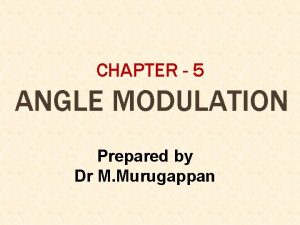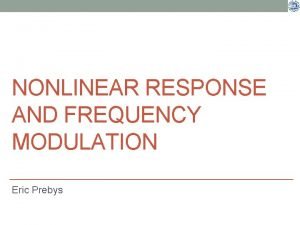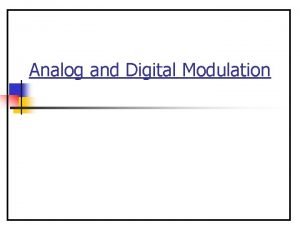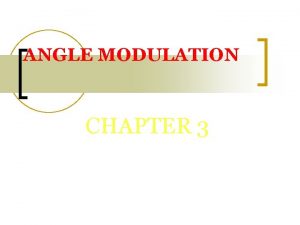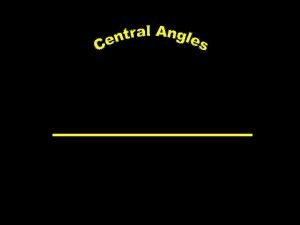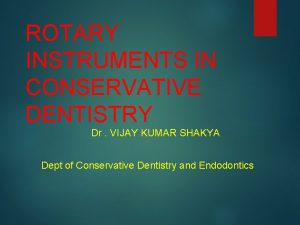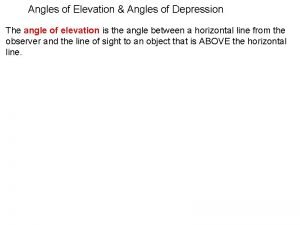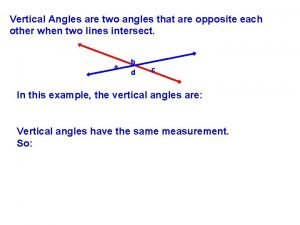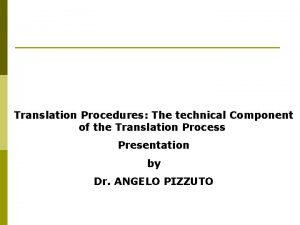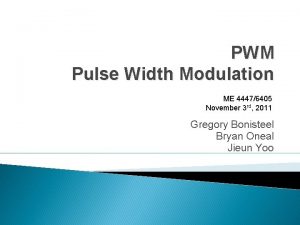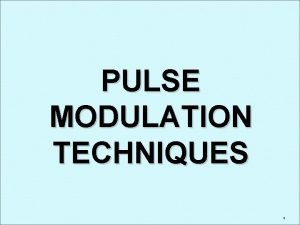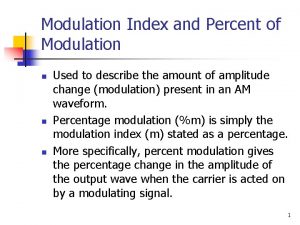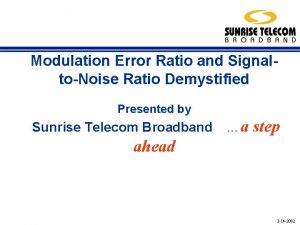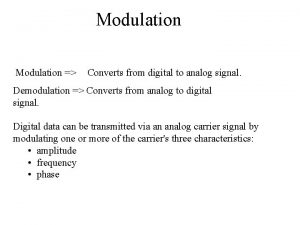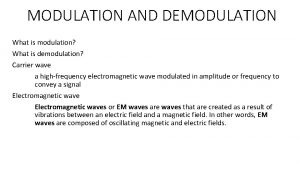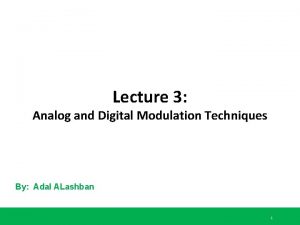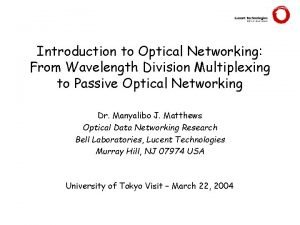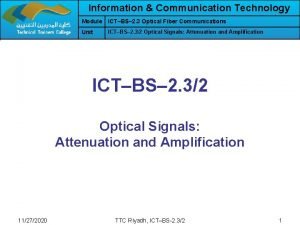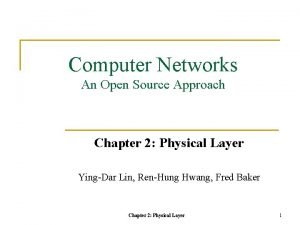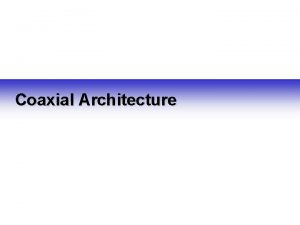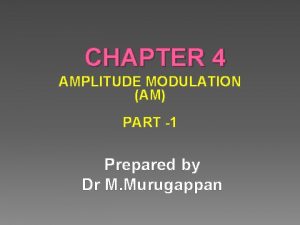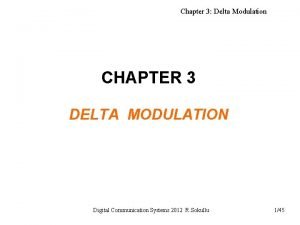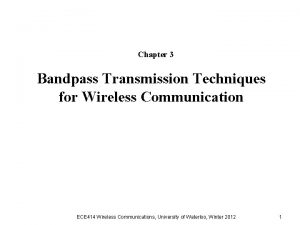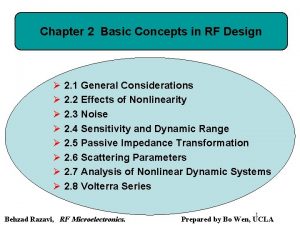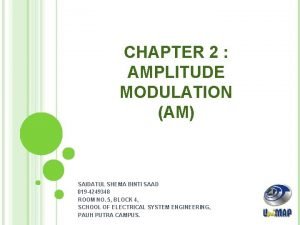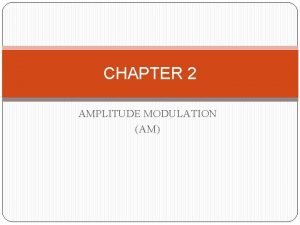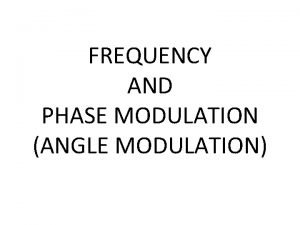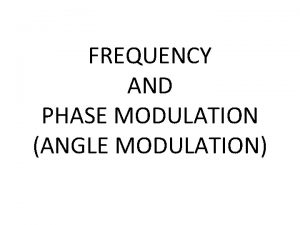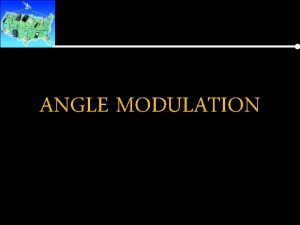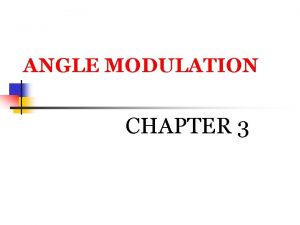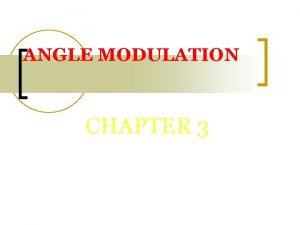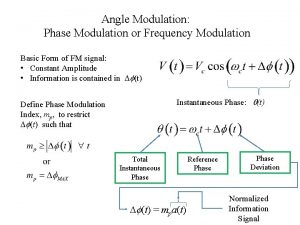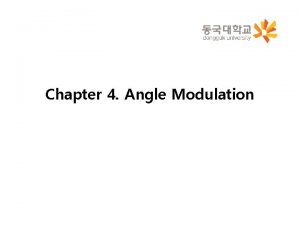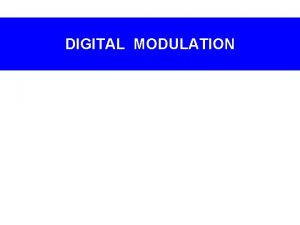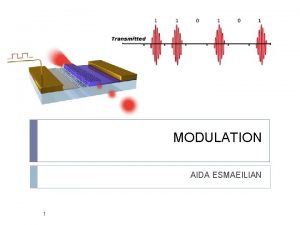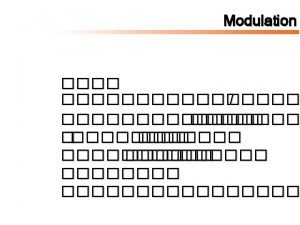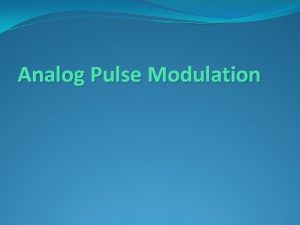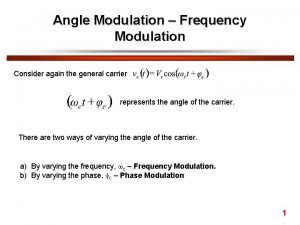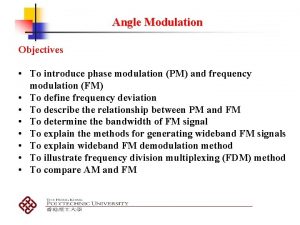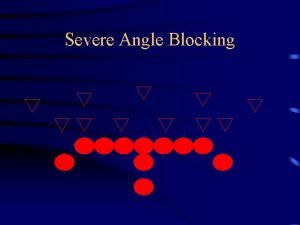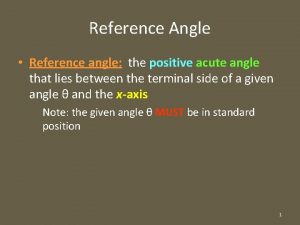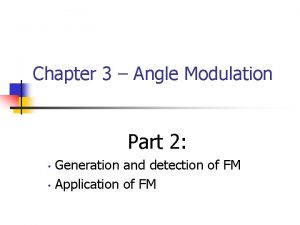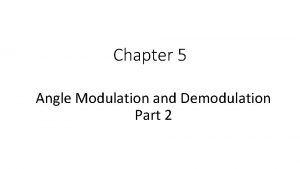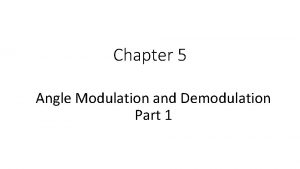ANGLE MODULATION CHAPTER 3 ANGLE MODULATION Part 1






















































- Slides: 54

ANGLE MODULATION CHAPTER 3

ANGLE MODULATION Part 1 n. Introduction

Introduction n Angle modulation is the process by which the angle (frequency or phase) of the carrier signal is changed in accordance with the instantaneous amplitude of modulating or message signal.

Cont’d… n classified into two types such as ¡ ¡ n Frequency modulation (FM) Phase modulation (PM) Used for : ¡ ¡ ¡ Commercial radio broadcasting Television sound transmission Two way mobile radio Cellular radio Microwave and satellite communication system

Cont’d… Advantages over AM: Ø Ø Ø Freedom from interference: all natural and external noise consist of amplitude variations, thus receiver usually cannot distinguish between amplitude of noise or desired signal. AM is noisy than FM. Operate in very high frequency band (VHF): 88 MHz-108 MHz Can transmit musical programs with higher degree of fidelity.

FREQUENCY MODULATION PRINCIPLES n n In FM the carrier amplitude remains constant, the carrier frequency varies with the amplitude of modulating signal. The amount of change in carrier frequency produced by the modulating signal is known as frequency deviation.

Carrier Resting fc Increasing fc Decreasing fc Increasing fc Resting fc Modulating signal FM

PHASE MODULATION(PM) n n The process by which changing the phase of carrier signal in accordance with the instantaneous of message signal. The amplitude remains constant after the modulation process. Mathematical analysis: Let message signal: And carrier signal:

PM (cont’d) n Where = phase angle of carrier signal. It is changed in accordance with the amplitude of the message signal; n i. e. n After phase modulation the instantaneous voltage will be or n Where mp = Modulation index of phase modulation K is a constant and called deviation sensitivities of the phase n

FREQUENCY MODULATION (FM) n n A process where the frequency of the carrier wave varies with the magnitude variations of the modulating or audio signal. The amplitude of the carrier wave is kept constant.

FM(cont’d) n Mathematical analysis: Let message signal: n And carrier signal: n

FM (cont’d) n During the process of frequency modulations the frequency of carrier signal is changed in accordance with the instantaneous amplitude of message signal. Therefore the frequency of carrier after modulation is written as n To find the instantaneous phase angle of modulated signal, integrate equation above w. r. t. t

FM(cont’d) n Thus, we get the FM wave as: n Where modulation index for FM is given by

FM(cont’d) n Frequency deviation: ∆f is the relative placement of carrier frequency (Hz) w. r. t its unmodulated value. Given as:

FM(cont’d) n Therefore:

Equations for Phase- and Frequency-Modulated Carriers Tomasi Electronic Communications Systems, 5 e Copyright © 2004 by Pearson Education, Inc. Upper Saddle River, New Jersey 07458 All rights reserved.

Example (FM) n Determine the peak frequency deviation (∆f) and modulation index (m) for an FM modulator with a deviation sensitivity K 1 = 5 k. Hz/V and a modulating signal,

Example (PM) n Determine the peak phase deviation (m) for a PM modulator with a deviation sensitivity K = 2. 5 rad/V and a modulating signal,

FM&PM (Bessel function) n Thus, for general equation:

Bessel function

B. F. (cont’d) n It is seen that each pair of side band is preceded by J coefficients. The order of the coefficient is denoted by subscript m. The Bessel function can be written as n N = number of the side frequency Mf = modulation index n

Bessel Functions of the First Kind, Jn(m) for some value of modulation index

B. F. (cont’d)

Representation of frequency spectrum

Example n For an FM modulator with a modulation index m = 1, a modulating signal vm(t) = Vmsin(2π1000 t), and an unmodulated carrier vc(t) = 10 sin(2π500 kt). Determine the number of sets of significant side frequencies and their amplitudes. Then, draw the frequency spectrum showing their relative amplitudes.

Angle Modulation Part 2 n. FM Bandwidth n. Power distribution of FM n. Generation & Detection of FM n. Application of FM

FM Bandwidth n n Theoretically, the generation and transmission of FM requires infinite bandwidth. Practically, FM system have finite bandwidth and they perform well. The value of modulation index determine the number of sidebands that have the significant relative amplitudes If n is the number of sideband pairs, and line of frequency spectrum are spaced by fm, thus, the bandwidth is: For n≥ 1

FM Bandwidth (cont’d) n n n Estimation of transmission b/w; Assume mf is large and n is approximate mf + 2; thus Bfm=2(mf + 2)fm = (1) is called Carson’s rule

Deviation Ratio (DR) n The worse case modulation index which produces the widest output frequency spectrum. n Where ¡ ∆f(max) = max. peak frequency deviation ¡ fm(max) = max. modulating signal frequency

FM Power Distribution n As seen in Bessel function table, it shows that as the sideband relative amplitude increases, the carrier amplitude, J 0 decreases. n This is because, in FM, the total transmitted power is always constant and the total average power is equal to the unmodulated carrier power, that is the amplitude of the FM remains constant whether or not it is modulated.

FM Power Distribution (cont’d) n n In effect, in FM, the total power that is originally in the carrier is redistributed between all components of the spectrum, in an amount determined by the modulation index, mf, and the corresponding Bessel functions. At certain value of modulation index, the carrier component goes to zero, where in this condition, the power is carried by the sidebands only.

Average Power n The average power in unmodulated carrier n The total instantaneous power in the angle modulated carrier. n The total modulated power

Generation of FM n Two major FM generation: i) Direct method: straight forward, requires a VCO whose oscillation frequency has linear dependence on applied voltage. Advantage: large frequency deviation Disadvantage: the carrier frequency tends to drift and must be stabilized. example circuit: i) iii) iv) i) ii) Reactance modulator Varactor diode

Generation of FM (cont’d) ii) Indirect method: Frequency-up conversion. Two ways: i. ii. a. b. iii. Heterodyne method Multiplication method One most popular indirect method is the Armstrong modulator

Armstrong modulator Vm(t) fm Integrator Balanced modulator Phase shifter Vc(t) fc Frequency multiplier (x n) Down converter Crystal oscillator

Armstrong modulator n For example: Let fm =15 Hz and fc= 200 k. Hz At frequency deviation= 75 k. Hz, it need a frequency multiplication by a factor, n, n=75000/15=5000; So it need a chain of four triplers (34) and six doublers (26), ie: n= (34) x (26)=5184, But, n x fc=5000 x 200 k. Hz=1000 MHz So, down converter with oscillating frequency=900 MHz is needed to put fc in the FM band of 88 MHz-108 MHz

FM Detection/Demodulation n FM demodulation ¡ is a process of getting back or regenerate the original modulating signal from the modulated FM signal. ¡ It can be achieved by converting the frequency deviation of FM signal to the variation of equivalent voltage. ¡ The demodulator will produce an output where its instantaneous amplitude is proportional to the instantaneous frequency of the input FM signal.

FM detection (cont’d) n To detect an FM signal, it is necessary to have a circuit whose output voltage varies linearly with the frequency of the input signal. n The most commonly used demodulator is the PLL demodulator. Can be use to detect either NBFM or WBFM.

PLL Demodulator V 0(t) fi FM input Phase detector Low pass filter Amplifier fvco VCO Vc(t)

PLL Demodulator n The phase detector produces an average output voltage that is linear function of the phase difference between the two input signals. Then low frequency component is pass through the LPF to get a small dc average voltage to the amplifier. n After amplification, part of the signal is fed back through VCO where it results in frequency modulation of the VCO frequency. When the loop is in lock, the VCO frequency follows or tracks the incoming frequency.

PLL Demodulator Let instantaneous freq of FM Input, fi(t)=fc +k 1 vm(t), and the VCO output frequency, f VCO(t)=f 0 + k 2 Vc(t); f 0 is the free running frequency. n For the VCO frequency to track the instantaneous incoming frequency, fvco = fi; or n

PLL Demodulator n f 0 + k 2 Vc(t)= fc +k 1 vm(t), so, n If VCO can be tuned so that fc=f 0, then n Where Vc(t) is also taken as the output voltage, which therefore is the demodulated output

Comparison AM and FM n Its the SNR can be increased without increasing transmitted power about 25 d. B higher than in AM n Certain forms of interference at the receiver are more easily to suppressed, as FM receiver has a limiter which eliminates the amplitude variations and fluctuations. n The modulation process can take place at a low level power stage in the transmitter, thus a low modulating power is needed. n Power content is constant and fixed, and there is no waste of power transmitted n There are guard bands in FM systems allocated by the standardization body, which can reduce interference between the adjacent channels.

Application of FM n n FM is commonly used at VHF radio frequencies for high-fidelity broadcasts of music and speech (FM broadcasting). Normal (analog) TV sound is also broadcast using FM. The type of FM used in broadcast is generally called wide-FM, or W-FM A narrowband form is used for voice communications in commercial and amateur radio settings. In two-way radio, narrowband narrow-fm (N-FM) is used to conserve bandwidth. In addition, it is used to send signals into space.

Summary of angle modulation -what you need to be familiar with

Summary (cont’d)

Summary (cont’d) n a) b) Bandwidth: Actual minimum bandwidth from Bessel table: Approximate minimum bandwidth using Carson’s rule:

Summary (cont’d) n Multitone modulation (equation in general):

Summary (cont’d)

Summary (cont’d)Comparison NBFM&WBFM

ANGLE MODULATION Part 3 n. Advantages n. Disadvantages

Advantages n n n Wideband FM gives significant improvement in the SNR at the output of the RX which proportional to the square of modulation index. Angle modulation is resistant to propagation-induced selective fading since amplitude variations are unimportant and are removed at the receiver using a limiting circuit. Angle modulation is very effective in rejecting interference. (minimizes the effect of noise). Angle modulation allows the use of more efficient transmitter power in information. Angle modulation is capable of handing a greater dynamic range of modulating signal without distortion than AM.

Disadvantages n n Angle modulation requires a transmission bandwidth much larger than the message signal bandwidth. Angle modulation requires more complex and expensive circuits than AM.

END OF ANGLE MODULATION
 Advantages of angle modulation
Advantages of angle modulation Amplitude modulation vs frequency modulation
Amplitude modulation vs frequency modulation Wave modulation
Wave modulation Formula for modulation index
Formula for modulation index Part whole model subtraction
Part whole model subtraction Unit ratio definition
Unit ratio definition Part part whole
Part part whole What is a technical description?
What is a technical description? Front bar equipment
Front bar equipment The part of a shadow surrounding the darkest part
The part of a shadow surrounding the darkest part Part to part variation
Part to part variation Aa similarity theorem
Aa similarity theorem Critical.angle formula
Critical.angle formula First angle projection
First angle projection An angle whose vertex is the center of a circle
An angle whose vertex is the center of a circle Radial fissure bur
Radial fissure bur Absolute angle vs relative angle
Absolute angle vs relative angle Adjacent angles linear pair
Adjacent angles linear pair Name an angle adjacent to
Name an angle adjacent to  Angle klm and angle mln are complementary
Angle klm and angle mln are complementary Angle bisectors worksheet
Angle bisectors worksheet Angle addition postulate examples
Angle addition postulate examples What is extinction angle
What is extinction angle Angle 1 and angle 2 are complementary
Angle 1 and angle 2 are complementary The lip clearance angle is the angle formed by the *
The lip clearance angle is the angle formed by the * A bird sits on top of a lamppost. the angle of depression
A bird sits on top of a lamppost. the angle of depression What is the measure of angle 2?
What is the measure of angle 2? Angle side angle postulate
Angle side angle postulate Lesson 4 measuring angles
Lesson 4 measuring angles Third angle orthographic projection
Third angle orthographic projection Digital modulation advantages
Digital modulation advantages Examples of modulation in translation
Examples of modulation in translation Tina champagne sensory modulation and environment
Tina champagne sensory modulation and environment Trail edge modulation
Trail edge modulation Pulse code modulation conclusion
Pulse code modulation conclusion Percentage modulation
Percentage modulation Modulation error ratio
Modulation error ratio Modulation digital to analog
Modulation digital to analog What is demodulation
What is demodulation Kinematik sport
Kinematik sport Analog and digital modulation techniques
Analog and digital modulation techniques Cross phase modulation
Cross phase modulation Direct modulation
Direct modulation Ssin-802
Ssin-802 George kelly corollaries
George kelly corollaries Ask modulation constellation diagram
Ask modulation constellation diagram Cross modulation
Cross modulation Ask modulation constellation diagram
Ask modulation constellation diagram Principles of amplitude modulation
Principles of amplitude modulation Noise in analog modulation
Noise in analog modulation Delta modulation conclusion
Delta modulation conclusion Probability of error
Probability of error Cross modulation
Cross modulation Formula for modulation index
Formula for modulation index Principle of am
Principle of am
